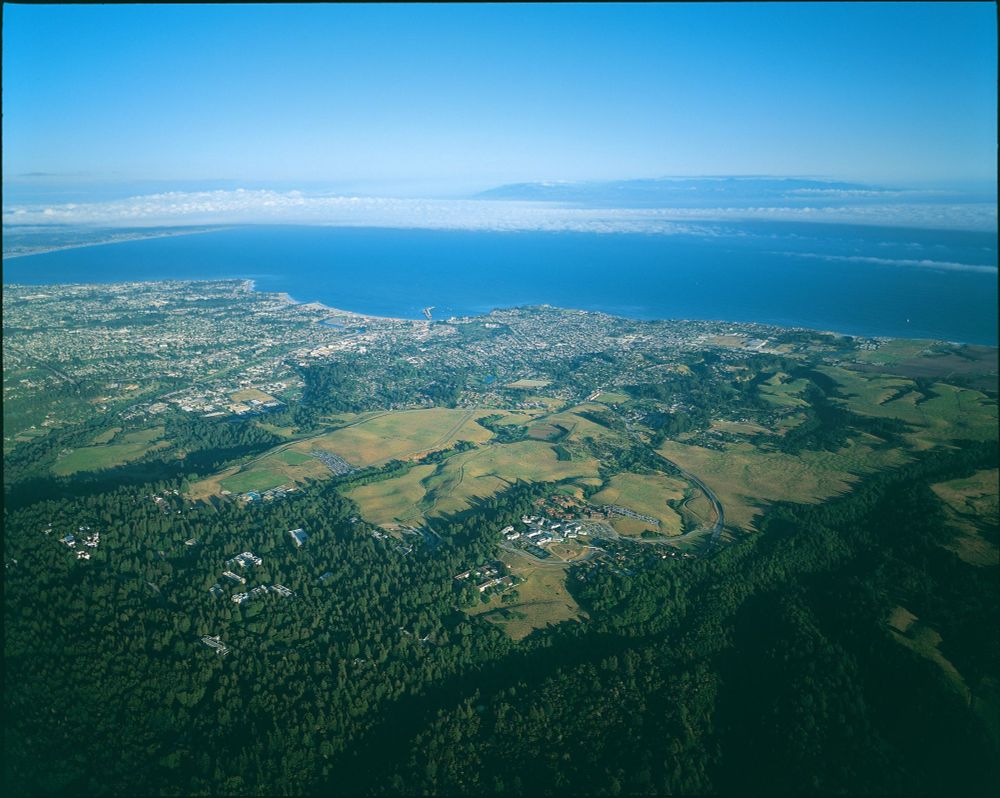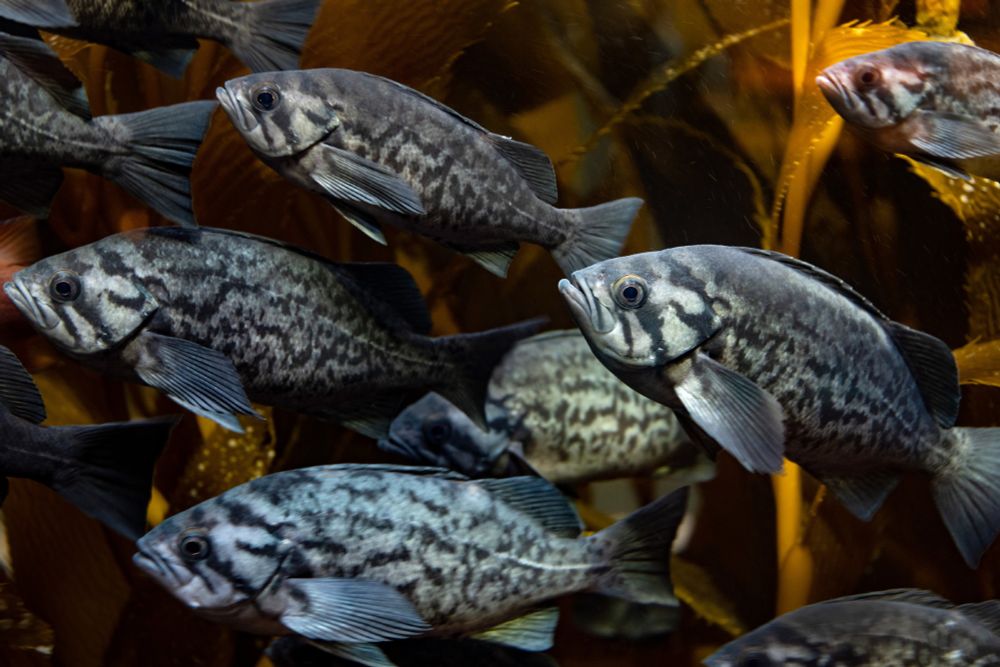Great work by the research team with the @montereybayaquarium.org's Sea Otter Program! You can read the full paper in Science Advances, detailing how a sea star collapse resulted in a mussel bonanza for sea otters, www.science.org/doi/10.1126/... #ecosystems #MarineLife
05.05.2025 16:51 — 👍 18 🔁 6 💬 0 📌 0
Huge thanks to my incredible co-authors at @montereybayaquarium.org @ucscscience.bsky.social and others not on here, and to the handling editor and anonymous reviewers whose feedback greatly improve the manuscript. (8/8)
01.05.2025 20:05 — 👍 2 🔁 0 💬 0 📌 0

Photos of our study area highlight the pronounced expansion of mussels towards lower intertidal zones (A and B are from Stillwater Cove), which increased mussel accessibility for foraging sea otters. (7/8)
01.05.2025 20:05 — 👍 1 🔁 0 💬 1 📌 0

This figure shows it all – under alternate hypothetical scenarios where urchins and mussels didn't increase, sea otter energy intake for the local population would have been much lower than what we actually observed. Mussels and urchins both contributed to elevated levels of energetic gain. (6/8)
01.05.2025 20:05 — 👍 0 🔁 0 💬 1 📌 0

Around the timing of the sea star wasting event (SSW), there was a sudden urchin boom resulting from a behavioral shift (which we previously described) in the subtidal. The mussel increase lagged by ~2-3 years, probably due to the time for mussels to recruit, survive, and grow. (5/8)
01.05.2025 20:05 — 👍 1 🔁 0 💬 1 📌 0

Mussel populations expanded throughout the rocky intertidal after (red) the loss of Pisaster and extended into lower tidal zones, increasing their accessibility for foraging sea otters. (4/8)
01.05.2025 20:05 — 👍 0 🔁 0 💬 1 📌 0

In Monterey, CA mussel populations surged due to predatory release from sea stars, creating a prey surplus for sea otters. (3/8)
01.05.2025 20:05 — 👍 0 🔁 0 💬 1 📌 0

In 2013, a sea star wasting event decimated populations of Pisaster ochraceus along the west coast of North America, leading to indirect effects on sea otters. (2/8)
01.05.2025 20:05 — 👍 1 🔁 0 💬 1 📌 0

Keystone interdependence: Sea otter responses to a prey surplus following the collapse of a rocky intertidal predator
Keystone interdependence occurs when shifts in one keystone species affect another, linking ecosystems across boundaries.
One of my favorite papers of my career is out in @science.org Science Advances, and we're on the cover! In this study, we introduce a new ecological process called keystone interdependence, where the loss of one keystone species can extend across ecosystems to indirectly affect another... (1/8)
01.05.2025 20:05 — 👍 5 🔁 1 💬 1 📌 0

A Monterey Bay Aquarium dive intern writes something on a white underwater clipboard while hovering upside-down in a murky kelp forest
Our dive interns have a direct impact on kelp forest research and conservation. They play an important role in collecting data on the biodiversity and function of kelp forests, and how sea otters contribute to their recovery.
16.04.2025 21:34 — 👍 84 🔁 6 💬 1 📌 1

Postdoctoral Scholar in Quantitative Marine Ecology
University of California, Santa Cruz is hiring. Apply now!
it's a hard and sad time in science / higher ed in the US right now. on the other hand, lots of PhDs are looking for work, so I wanted to share—
I'm hiring a postdoc!
it's a two-year position at UCSC to do (preferably Bayesian) modeling of marine ecosystems: recruit.ucsc.edu/JPF01892
07.04.2025 19:58 — 👍 111 🔁 75 💬 4 📌 2
I’ll soon be recruiting at all levels – stay tuned for opportunities! In the meantime, I’m delighted to mentor students applying for fellowships such as the NSF Graduate Research Fellowship, NSF Postdoc, Smith Conservation Fellowship, and others. Please reach out! (2/2).
#newPI #newFaculty
05.04.2025 17:00 — 👍 4 🔁 0 💬 0 📌 0

I’m ✨ elated ✨ to share that I’ll be joining the faculty at UC Santa Cruz this fall as an Assistant Professor in the Department of Ecology and Evolutionary Biology! My lab at UCSC will study subtidal and nearshore community ecology (1/2).
05.04.2025 17:00 — 👍 27 🔁 2 💬 3 📌 0

Academic Coordinator I for the Guide to the Geographic Approach program, Department of Geography
University of California Santa Barbara is hiring. Apply now!
Check out this new job possibility! @ucsb.bsky.social is seeking an academic coordinator on a super exciting new GIS/data science curriculum project recruit.ap.ucsb.edu/JPF02916
#gischat #geosky
01.04.2025 22:52 — 👍 21 🔁 15 💬 1 📌 0

We are now accepting applications for our paid 2025 kelp forest scientific diving #internships at @montereyaq.bsky.social! 🤿 Must be a current student or recent grad (grad students are eligible!). Apply at the link below by February 7 recruiting2.ultipro.com/MON1023MBAF/...
#kelpforest #ecology
12.01.2025 02:15 — 👍 2 🔁 0 💬 0 📌 0

👉Conservation performance significantly increased with increasing MPA age and habitat diversity. (4/5)
10.01.2025 02:45 — 👍 1 🔁 0 💬 1 📌 0

👉Targeted fish species biomass was significantly higher in 22 out of 59 MPAs (37%), although 46 (78%) had elevated biomass in MPAs. (3/5)
10.01.2025 02:45 — 👍 1 🔁 0 💬 1 📌 0

👉At the scale of California's MPA network, targeted (i.e., fished) fish biomass was significantly greater inside no-take MPAs compared with areas that allowed take.
.
👉Three out of 4 regions exhibited significantly higher targeted fish biomass inside no-take MPAs. (2/5)
10.01.2025 02:45 — 👍 0 🔁 0 💬 1 📌 0

Our study published today in @society4conbio.bsky.social shows that the conservation performance of marine protected areas (MPAs) accrues across ecosystems in individual MPAs and in a large MPA network. We synthesized decades of monitoring data collected across four ecosystems and found... (1/5)
10.01.2025 02:45 — 👍 10 🔁 4 💬 1 📌 1

A school of blue rockfish swim in the Kelp Forest exhibit at Monterey Bay Aquarium. Their gray and white patterned scales stand out in stark contrast against the darker golden brown blades of the kelp.
Is California’s network of science-based marine protected areas (MPAs) effective at conserving marine fish populations? The answer is a resounding yes, according to a new study from the National Center for Ecological Analysis and Synthesis (NCEAS). conbio.onlinelibrary.wiley.com/doi/10.1111/...
09.01.2025 18:05 — 👍 193 🔁 62 💬 4 📌 1
Associate Prof at University of Colorado. I study the effects of climate change on ecosystems and people. Interested in how to effectively design and evaluate nature based solutions, evidence, and strategies for climate adaptation and conservation. She/her
Responsible for instigating some of humanity’s most high-impact discoveries.
Visit us at https://science.ucsc.edu/ 🐋 🔭 🧬
Ecologist working on the conservation and restoration of macroalgal marine forests. Current postdoc at MBA, Plymouth, UK🌱🌊 BEECH, MedRecover and MarineForest groups
🌊 Marine Ecologist | 🎓 PhD Candidate | 🌍 Afro-Caribbean Latina in STEM| NatGeoExplorer
🌱 Nature lover studying marine life from the coasts to the deep sea
🐟 Posts: #MarineLife, #Kelp, #BlackInSTEM, #BLM, #SocialJustice, #EnvJustice & more
🕊🇵🇸
Marine ecologist working on #ClimateChange impacts & the conservation of #kelp forests and #seagrass meadows. Passionate about storytelling in all its forms
I'm a PhD candidate in the Micheli Lab at Hopkins Marine Station
she/her | 🐟🌱🫧 studying marine species interactions and ecophysiology under climate change stressors (ocean acidification, hypoxia)
Bioengineer in MBARI’s Bioinspiration Lab, Smithsonian’s NMNH, Caltech, National Geographic Explorer, former USA ice dancer. Dog + cat mom. Hater of inefficiency and waste. Views are my own. she/her
Independent journalist, features editor at bioGraphic, contributing editor at Adventure Journal, essayist, mom, "queen of delicious verbs." A watery soul in an arid land.
Scientific research institution on the coastal margin of British Columbia, Canada | Part of the Tula Foundation
🐚 Saving wild ocean places for us and future generations
🩵 Blue Parks 🌊 Blue Sparks
📌 Map Your Love for the Ocean
https://marine-conservation.org/
Assistant Professor of Ocean Sciences at UCSC. Modeling ecological and biogeographical dynamics in past, current, and future seas.
The official account of UC San Diego. #3 public university, #1 in your hearts. 🔱
Official Bluesky of #UCSB 🎓 A top-ranked public university where beauty meets brilliance 💛 ucsb.edu
Official account of University of California, Santa Cruz. Go Slugs!
ucsc.edu
Nonprofit aquarium committed to Inspiring Conservation of Our Marine Environment. Join us in protecting our one world ocean—from the Salish Sea to the Coral Triangle.
The Ocean Pavilion is now open! Visit our expanded campus today.
US NSF postdoc at the Monterey Bay Aquarium Research Institute
Incoming Group Leader at University of Zurich (www.woestreich.com)
I explore the ecology of collective behavior in dynamic ecosystems.
Posts about ecology, evolution, waves, music, etc.
We work to create lasting protections for local waterways using community science, research, education, and advocacy. Our ambassador is the North American River Otter – an indicator of healthy waters.
Otters for Waters
https://riverotterecology.org/
As advisors to the nation, we recognize and advance outstanding science for the benefit of society. Journals: @pnas.org and @pnasnexus.org | President: Marcia McNutt
Father, husband, earthling, scientist curious how nature works with a bias towards the ocean. Associate professor at Sonoma State University - hughesecology.com


















